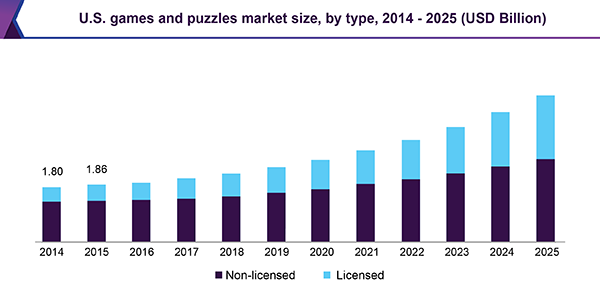The global games and puzzles market size is expected to reach USD 29.95 billion by 2025, according to a new report by Grand View Research, Inc., exhibiting a CAGR of 16.1% during the forecast period. Advancements in the 3D printing technology are allowing card and board game manufacturers to enhance conventional play patterns, thereby helping the market to gain remarkable momentum over the coming years.
Educational institutes are getting keen on developing cognitive thinking capabilities of children, as a result of which they have started including puzzles and board games in their educational curriculums, which can improve logical reasoning, critical thinking, and problem-solving skills in kids. Another factor contributing to surging demand for such educational puzzles and brainteasers is shifting preference of teenagers and adults towards toys, such as Rubik’s cube, Sagrada, Gloomhaven, and Quantum for memory strengthening.
Internet retailing is emerging as a lucrative mode of distribution for manufacturers of toys and puzzles. Strong relationships established by these manufacturers with online retailers coupled with increasing campaigns and promotional strategies are estimated to propel the market over the forecast period.
Sales at brick and mortar stores tend to be high during holidays, particularly due to seasonal demand. However, sales at brick and mortar stores are plummeting as consumers are switching to e-commerce portals because of the ease of shopping. Having realized such changes in consumer behavior, retailers are making efforts to complement conventional retail with e-commerce, so that they can cater to a larger consumer base.
Several mass chain stores, such as Wal-Mart Stores, Inc., and online jigsaw puzzle resellers, such as Puzzle Warehouse, are stocking and distributing products through brick and mortar stores as well as e-commerce portals. Game manufacturers are focusing on establishing healthy business relationships with them.
Board game designers are adopting latest technologies in order to attract consumers in already saturated markets. Their efforts to incorporate trending technologies into board games are leading to development of mobile apps that can assist and enhance the gameplay in board games. Such board game apps can be categorized into full gameplay, buddy apps, and core apps.
Board games are also being integrated with digital technology. For instance, PlayTable, a tabletop gaming console designed for board games, can hold a large gaming library. PlayTable allows users to set up the board, modify the game, and integrate smart pieces to make the game more interactive.

To request a sample copy or view summary of this report, click the link below:
Further key findings from the report suggest:
- The licensed games and puzzles segment is expected to witness phenomenal growth over the forecast period, as customers emphasize on premium quality and originality of products
- Distribution via brick and mortar channel is estimated to dominate the market over the forecast period due to heightened sales during the holiday season
- Asia Pacific is projected to account for almost 56.0% of the revenue generation by 2025. Low-cost manufacturing facilities in China and Japan are sites of high growth rates in the region.
- Some of the prominent companies operating in the market are Buffalo Games, Cobble Hill, Hasbro, Ravensburger AG, and Springbok Puzzles.